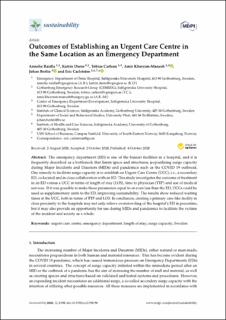Outcomes of establishing an urgent care centre in the same location as an emergency department
Raidla, Annelie; Darro, Katrin; Carlson, Tobias; Khorram-Manesh, Amir; Berlin, Johan; Carlström, Eric
Peer reviewed, Journal article
Published version
Permanent lenke
https://hdl.handle.net/11250/2733105Utgivelsesdato
2020Metadata
Vis full innførselSamlinger
Originalversjon
Raidla, A., Darro, K., Carlson, T., Khorram-Manesh, A., Berlin, J., & Carlström, E. (2020). Outcomes of establishing an urgent care centre in the same location as an emergency department. Sustainability, 12(19). https://doi.org/10.3390/su12198190Sammendrag
The emergency department (ED) is one of the busiest facilities in a hospital, and it is frequently described as a bottleneck that limits space and structures, jeopardising surge capacity during Major Incidents and Disasters (MIDs) and pandemics such as the COVID 19 outbreak. One remedy to facilitate surge capacity is to establish an Urgent Care Centre (UCC), i.e., a secondary ED, co-located and in close collaboration with an ED. This study investigates the outcome of treatment in an ED versus a UCC in terms of length of stay (LOS), time to physician (TTP) and use of medical services. If it was possible to make these parameters equal to or even less than the ED, UCCs could be used as supplementary units to the ED, improving sustainability. The results show reduced waiting times at the UCC, both in terms of TTP and LOS. In conclusion, creating a primary care-like facility in close proximity to the hospitals may not only relieve overcrowding of the hospital’s ED in peacetime, but it may also provide an opportunity for use during MIDs and pandemics to facilitate the victims of the incident and society as a whole.

